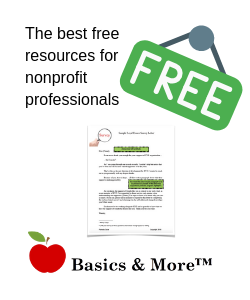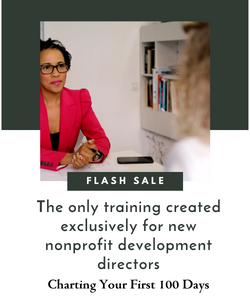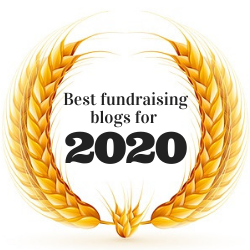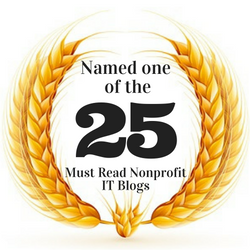Off record, Pam Grow and I chat often on the state of fundraising. We notice a lot of the same things and – to be blunt – it’s a relief to know you’re not the only one on the block thinking it.
 Lately it’s been that the 24/7 donor communications fiesta … is getting a little tired.
Lately it’s been that the 24/7 donor communications fiesta … is getting a little tired.
Same old players, same old info, recycled the same old ways: more you/less we, Flesch Kincaid and readability, ban all jargon, timely thank-yous, and on and on and on.
Then Nancy Schwartz wrote this. She said:
“[It’s] about WE…not you. This is a critical shift in voice that I’m starting to feel is very important. For so long, experts have advised cause communicators to address prospects and supporters in second person—you. The shift to WE—signaling the power of collective action for stronger results—is a vital strategic shift.”
Having heard countless nonprofit pundits tell you to circle every instance of ‘we’ in your appeals and find a way to replace all of them with ‘you,’ some of you are no doubt shaking your heads. No doubt you’re thinking, So now ‘we’ is okay? Puh-leeze.
Then why was I nodding my head (while shouting, “YES, Nancy!”), at her post?
Because I too had noticed that same shift.
The shift that donors want something more.
Then on Monday I read Vu Le’s superb post on community-centered fundraising.
Again I found myself shouting, “YES!” … and I knew it was time to speak out.
Because quietly and since 2010, I’d been letting words like “we” and “us” creep into my copy. Not the look-at-how-great-we-are, institutional “we.” (See Future Fundraising Now for more. Also heed the advice on “I.”)
No, no, no.
I’m talking about the we’re-in-this-together, you-and-me “we.”
Quietly, I’d been including stuff in appeal letters, donor newsletters, and acknowledgments that quite frankly fly in the face of what a long line of experts tells you is handsdown bad and would bring about the equivalent of some kind of nonprofit Armageddon.
But I couldn’t shake the shift.
What’s more, donors were responding. Call it donor realism. Call it community-centered fundraising. Call it whatever you like.
The results I saw mattered more.
Double-digit response rates to newsletters. Sixty-five percent retention rates. Lapsed donors returning. Increased feedback. Plus signs, big and small, that we’d struck a chord.
There were other things my clients and I had been doing. I’ll share some with you momentarily. To me it’s early proof that a seismic shift must occur in the way you and I communicate with donors.
Does it mean the death of donor centrism? Does it mean you stop treating donors well? Does it mean no more “you” in copy?
No. That would just be absurd. Over at Nonprofit With Balls, Vu put it best: “Adopt the great stuff from donor-centric fundraising as a default.”
But when famous consultants start blogging that words like “programs” and “services” are jargon (true story), I believe that we, as an industry, are in deep, deep trouble.
Are we so lukewarm about our work we’re afraid that people will stop giving simply at the mention of a word like “program”?
People of fundraising, your donors can take it.
Because more than anything, what they crave isn’t a bunch of copy with artificial “yous” inserted all over the place. What they crave isn’t always even the story of one (proof here).
What they crave is authenticity.
What they crave is to be treated like the incredible insiders they are.
What they crave is to feel knowledgeable and enlightened and part of something bigger.
Here are a few ways my clients and I have been making this subtle shift in voice and practice that – if I have anything to do with it – will continue to change and grow:
1. We use words like “we” and “us” to inspire action and engagement. Refer to Vu’s and Nancy’s posts mentioned above. As Vu wrote, “None of us are heroes without all of us.” He’s spot on. (Warning: if you think this clears you to use the institutional “we,” banish the thought. Then read Tom Ahern’s books.) We use “I” a lot, too.
2. We don’t hide our partnerships with other organizations. In a donor newsletter, we recently highlighted a program that one of my clients runs in partnership with another charity. On their own, neither had the resources to fund it. But the need was there, so they joined together to make it possible. Donors loved it. (Note: If you’re worried that name-checking another org will spark a donation migration, don’t be. Most donors give to multiple causes. Chances are, they already give to your program partner anyway. Even if they don’t, you showed a remarkably genuine, generous side of yourself by sharing.)
3. We show struggle. And yes, sometimes defeat. This is an old copywriting adage we call “show your warts” that holds true for nonprofits – it’s transparency like you’ve never seen. In a recent appeal from one client’s CEO, we talked about his six-month struggle to get government funding for an important program. He talked about the budget – what was included, and what they denied. We framed it honestly, without bashing anyone: times are tough for everyone. Donors came through with flying colors.
4. We are unabashed adapters of The Big E. I can’t express how much I agree with Vu Le on this one when I say: Educate Your Donors. But not in the organization-focused way it’s been presented all these years. In your donor newsletters, share updates on programs. Talk about bigger issues – even some you might not be able to tackle yet. Showcase your staff, and what they see. Share numbers. Take donors inside the work you do…the work they make possible! Overwhelmingly, we’ve seen that donors are thrilled to feel like experts around causes they believe in.
5. We use jargon. Am I paving the way for gems like “paradigm” and “stakeholder”? Does it mean you can now start using “food insecure” for someone who is going hungry? Or “housing challenged” for someone who is homeless? No way, no how!
What I do mean by jargon is that you need to get real.
If you’ve been given provisional state funding or short-term, contingent funding, say so. If you need to talk about a gap in the budget, do it. If in-network healthcare is being moved from your area at an alarming rate, leaving the lives of good people hanging in the balance, say so. Over-the-top ego stroking just makes you sound like “the used car salesmen of justice” (Vu again, eloquently).
6. Our thank-you letters often serve as receipts. I’ve been openly criticized for this, and I hold firm. Nearly ten years ago I crafted all the donor acknowledgements for what has become one of the largest animal welfare charities of all. We told folks that, to conserve resources and help more animals, their (lovely, personal, timely and sincere) thank-you should be saved for their records, because it also doubled as a tax receipt. Donor feedback was fantastic; retention didn’t dip. Another of my clients includes a BRE in their otherwise uncompromisingly no-ask thank-yous – a practice I myself railed against for years. Again they’ve seen no drop in retention, and donors have written back to thank them for sending an extra postage-paid envelope.
Programs and services are not dirty words. Maximizing donations is not a taboo topic.
Needing the money to pay for overhead – electricity to keep the lights on, the water running, and boots on the ground – is nothing to be ashamed of.
Speaking of unashamed, if you visit my (ridiculously outdated/overhaul coming) website and find that some of my advice here seems to have changed slightly from advice of ten – or even five – years ago?
It has.
I’m not ashamed to say that the way I communicate with donors is ever changing. That every day, these good people teach me something new. That I hope I never stop learning as long as I live.
Vu and Nancy are onto something. Listen up.
PS I’ll make a prediction neither one of them has. More and more, I’m seeing properly crafted donor newsletter packs pull their weight as never before (like 7:1 ROI good). I’m talking a proper mix of content, infographics (NOT pie charts), design, quality writing, reporting back/gratitude, opportunities – things like that. Even among very new donors. I could be completely sucking wind on this theory. But my guess is it’s another sign that same-old won’t fly.
Today’s guest post is courtesy of my dear friend, Lisa Sargent, Nonprofit Copywriter and Communicator Extraordinaire. Subscribe to The Loyalty Letter, Lisa’s monthly e-newsletter.

















 I can’t wait to meet with you personally.
I can’t wait to meet with you personally.
Comments on this entry are closed.